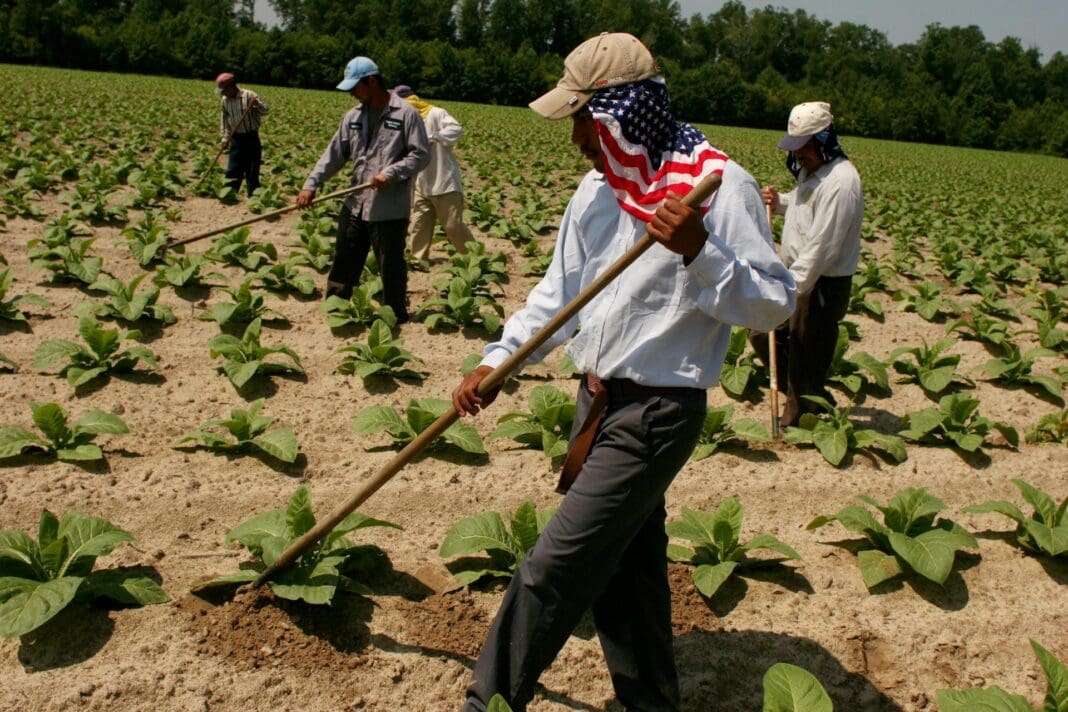The U.S. has an important choice to make regarding agriculture.
It can import more people to pick crops and do other kinds of agricultural labor, it can raise wages enough to lure more U.S. citizens and immigrants with legal status to take these jobs, or it can import more food. All three options contradict key Trump administration priorities: reducing immigration, keeping prices low and importing fewer goods and services.
The big tax-and-spending bill President Donald Trump signed into law on July 4, 2025, included US$170 billion to fund the detention and deportation of those living in the U.S. without authorization. And about 1 million of them work in agriculture, accounting for more than 40% of all farmworkers.
As the detention and deportation of undocumented immigrants ramps up, one emerging solution is to replace at least some deported farmworkers with foreigners who are given special visas that allow them to help with the harvest but require them to go home after their visas expire.
Such “guest worker” programs have existed for decades, leading to today’s H-2A visa program. As of 2023, more than 310,000 foreigners, around 13% of the nation’s 2.4 million farmworkers, were employed through this program. About 90% of the foreign workers with these visas come from Mexico, and nearly all are men. The states where the largest numbers of them go are California, Florida, Georgia and Washington.
As a professor of Latin American politics and U.S.-Latin American relations, I teach my students to consider the difficult trade-offs that governments face. If the Trump administration removes a significant share of the immigrants living in the U.S. without legal permission from the agricultural labor force to try to meet its deportation goals, farm owners will have few options.

First, farm owners could raise wages and improve working conditions enough to attract U.S. citizens and immigrants who are legal permanent residents or otherwise in the U.S. with legal status.
But many agricultural employers say they can’t find enough people to hire who can legally work – at least without higher wages and much-improved job requirements. Without any undocumented immigrant farmworkers, the prices of U.S.-sourced crops and other agricultural products would spike, creating an incentive for more food to be imported.
Second, farm owners could employ fewer people. That would require either growing different crops that require less labor or becoming more reliant on machinery to plant and harvest. But that would mean the U.S. could have to import more food. And automation for some crops is very expensive. For others, such as for berries, it’s currently impossible.
It’s also possible that some farm owners could put their land to other uses, ceasing production, but that would also necessitate more imported food.
U.S. Agriculture Secretary Brooke Rollins has predicted that farm owners will soon find plenty of U.S. citizens to employ.
She declared on July 8 that the new Medicaid work requirements included in the same legislative package as the immigration enforcement funds would encourage huge numbers of U.S. citizens to start working in the fields instead of losing their health insurance through that government program.
Farm trade groups say this scenario is far-fetched.
For one thing, most adults enrolled in the Medicaid program who can work already do. Many others are unable to do so due to disabilities or caregiving obligations.
Few people enrolled in Medicaid live close enough to a farm to work at one, and even those who do aren’t capable of doing farmwork. When farm owners tried putting people enrolled in a welfare program to work in the fields in the 1990s, it failed. Another experiment in the 1960s, which deployed teenagers, didn’t pan out either because the teens found the work too hard.
It seems more likely that farm owners will try to hire many more foreign farmworkers to do temporary but legal jobs through the H-2A program.
Although he has not made it an official policy, Trump seems to be moving toward this same conclusion.
In June, for example, Trump said his administration was working on “some kind of a temporary pass” for immigrants lacking authorization to be in the U.S. who are working on farms and in hotels.
The guest worker system, established in 1952 and revised significantly in 1986, has become a mainstay of U.S. agriculture because it offers important benefits to both the farm owners who need workers and the foreign workers they hire.
There is no cap on the number of potential workers. The number of H-2A visas issued is based only on how many employers request them. Farm owners may apply for visas after verifying that they are unable to locate enough workers who are U.S. citizens or present in the U.S. with authorization.
To protect U.S. workers, the government mandates that H-2A workers earn an “adverse effect wage rate.” The Labor Department sets that hourly wage, which ranges from $10.36 in Puerto Rico to about $15 in several southern states, to more than $20 in California, Alaska and Hawaii. These wages are set at relatively high levels to avoid putting downward pressure on what other U.S. workers are paid for the same jobs.
After certification, farm owners recruit workers in a foreign country who are offered a contract that includes transportation from their home country and a trip back – assuming they complete the contract.
The program provides farm owners with a short-term labor force. It guarantees the foreign workers who obtain H-2A visas relatively high wages, as well as housing in the U.S. That combination has proven increasingly popular in recent years: The annual number of H-2A visas rose to 310,700 in 2023, a more than fivefold increase since 2010.

Boosting the number of agricultural guest workers would help fill some gaps in the agricultural labor force and reduce the risk of crops going unharvested. But it seems clear to me that a sudden change would pose risks for workers and farm owners alike.
Workers would be at risk because oversight of the H-2A program has historically been weak. Despite that lax track record, some unscrupulous farmers have been fined or barred from participating in the H-2A program because of unpaid wages and other abuses.
Relying even more on guest farmworkers than the U.S. does today would also swap workers who have built lives and families north of the border with people who are in the U.S. on a temporary basis. Immigration opponents are unlikely to object to this trade-off, but to immigrant rights groups, this arrangement would be cruel and unfair to workers with years of service behind them.
What’s more, the workers with guest visas can be at risk of exploitation and abuse. In 2022, the U.S. attorney for the Southern District of Georgia described conditions for H-2A workers at an onion farm the government had investigated as “modern-day slavery.”
For farm owners, the downside of ramping up guest worker programs is that it could increase costs and make production less efficient and more costly. That’s because transporting Mexican farmworkers back and forth each year is complicated and expensive. Farm groups say that compliance with H-2A visa requirements is cumbersome. It can be particularly difficult for small farms to participate in this program.
Some farm owners have objected to the costs of employing H-2A workers. Rollins has said that the Trump administration believes that the mandatory wages are too high.
To be sure, these problems aren’t limited to agriculture. Hotels, restaurants and other hospitality businesses, which rely heavily on undocumented workers, can also temporarily employ some foreigners through the H-2B visa program – which is smaller than the H-2A program, limits the number of visas issued and is available only for jobs considered seasonal.
Home health care providers and many other kinds of employers who rely on people who can’t legally work for them could also struggle. But so far, there is no temporary visa program available to help them fill those gaps.
If the U.S. does deport millions of workers, the price of tomatoes, elder care, restaurant meals and roof repairs would probably rise substantially. A vast increase in the number of guest workers is a potential but partial solution, but it would multiply problems that are inherent in these temporary visa programs.
This article is republished from The Conversation, a nonprofit, independent news organization bringing you facts and trustworthy analysis to help you make sense of our complex world. It was written by: Scott Morgenstern, University of Pittsburgh
Read more: Providing farmworkers with health insurance is worth it for their employers − new research Deporting millions of immigrants would shock the US economy, increasing housing, food and other prices President Carter had to balance employers’ demands for foreign workers with pressure to restrict immigration – and so does Trump
Scott Morgenstern does not work for, consult, own shares in or receive funding from any company or organization that would benefit from this article, and has disclosed no relevant affiliations beyond their academic appointment.













